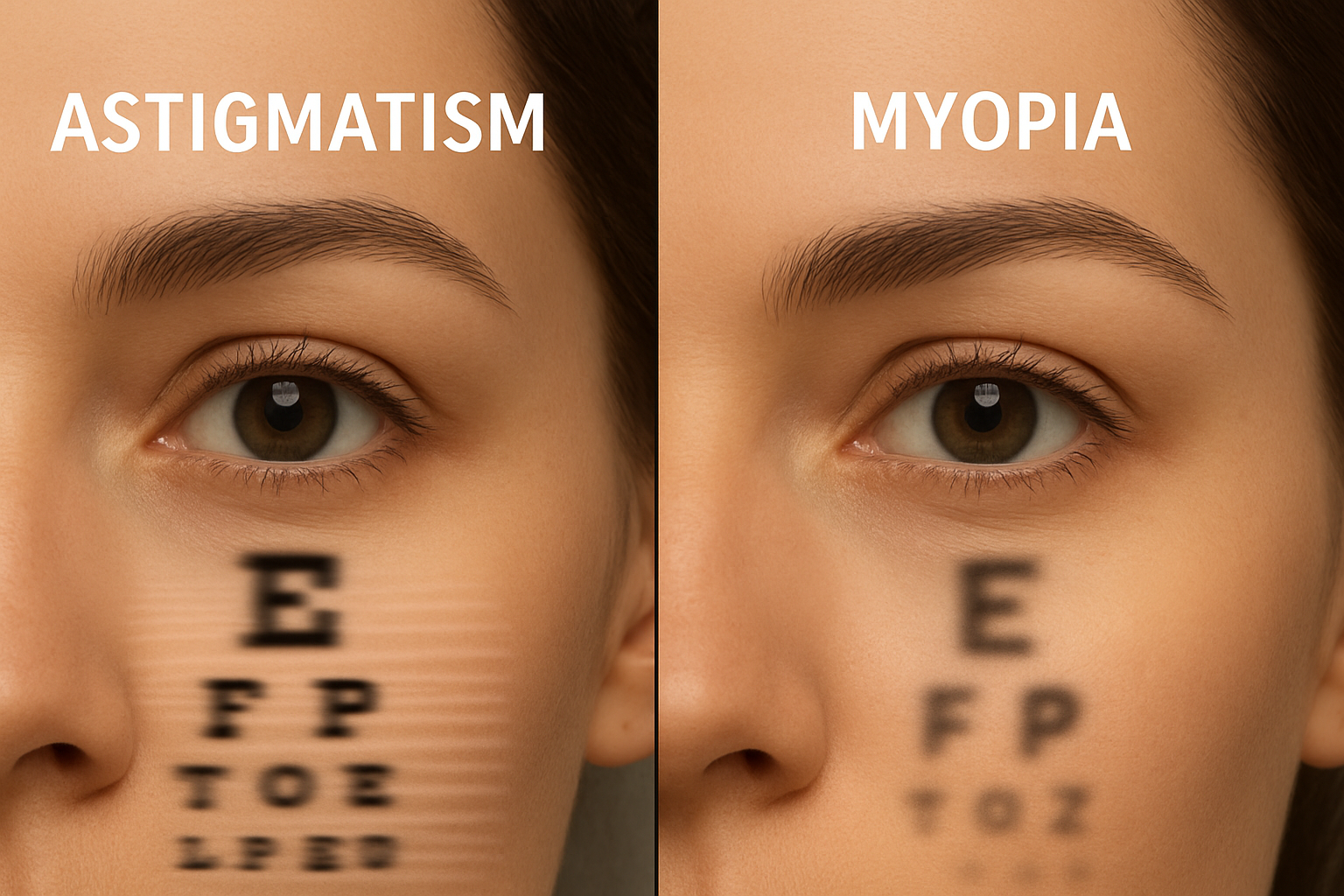Clear vision is something most of us take for granted until it starts to change. When people notice blurry vision, difficulty reading signs, or discomfort while focusing on objects, two common conditions often come up: astigmatism and myopia. These eye conditions may seem similar because they both cause blurred vision, but they are actually very different in how they develop and how they affect eyesight.
In this article, we will explore astigmatism vs myopia in detail, explaining what each condition means, how they differ, and how they are diagnosed and treated. Understanding the difference is important because it helps people recognize symptoms early and seek the right care. Since vision plays a central role in daily life — from driving to reading to using digital devices — learning about these conditions can help people make informed decisions about eye health.
What Is Astigmatism?
Astigmatism is a common refractive error that occurs when the eye’s surface is not perfectly round. Instead of being shaped like a smooth basketball, the cornea or lens has more of an oval or football-like shape. This irregular curve causes light entering the eye to bend unevenly, preventing it from focusing clearly on the retina.
In simple terms, astigmatism makes vision appear blurry or distorted at any distance. Unlike other vision problems that only affect near or far vision, astigmatism can cause issues no matter what you are trying to see.
People with astigmatism often experience eye strain, headaches, and trouble seeing fine details. They may notice that letters on a page look fuzzy or that lights at night appear stretched or halo-like. While mild astigmatism can sometimes go unnoticed, stronger cases often interfere with reading, driving, and other daily tasks.
What Is Myopia?
Myopia, commonly known as nearsightedness, is another widespread refractive error. In this condition, the eye is slightly longer than normal, or the cornea is too curved. As a result, light entering the eye focuses in front of the retina instead of directly on it.
This means that people with myopia can see nearby objects clearly, but distant objects appear blurry. For example, a person may have no problem reading a book up close but struggle to read a street sign or see the board in a classroom.
Typical symptoms of myopia include squinting, difficulty driving at night, and frequent eye strain. Myopia usually develops during childhood or teenage years and may worsen as the eye grows. Because of the increasing use of digital devices and reduced outdoor time, myopia rates are rising globally, making it a significant public health concern.
Key Differences Between Astigmatism and Myopia
Although both astigmatism and myopia affect vision, they are not the same condition. The main difference lies in how each one changes the way light focuses inside the eye.
In astigmatism, the uneven shape of the cornea or lens causes light to scatter instead of focusing neatly. This leads to blurry or distorted vision at all distances. In contrast, myopia happens when the eye is too long or curved, causing light to focus in front of the retina. The result is clear near vision but blurred distance vision.
The causes of these conditions also differ. Astigmatism is primarily linked to irregular eye curvature, which can be present from birth or develop later. Myopia often has genetic and environmental influences, with lifestyle factors like screen time and limited outdoor activity playing a role.
For daily life, the impact varies. Someone with astigmatism may find both reading and driving challenging, while a person with myopia typically struggles more with distant objects. Both conditions, however, can interfere with school, work, and leisure activities if left untreated.
Can Astigmatism and Myopia Occur Together?
It is entirely possible to have both astigmatism and myopia in the same eye. In fact, many people experience this combination, known as myopic astigmatism. When both conditions are present, vision can be even more blurred or distorted, requiring precise correction to restore clarity.
This overlap means that some people need glasses or contact lenses designed to correct both conditions simultaneously. Understanding the possibility of having both helps explain why some individuals still struggle with clear vision even after getting basic corrective lenses. A proper eye exam ensures that both astigmatism and myopia are identified and treated correctly.
Diagnosis and Eye Exams
Distinguishing between astigmatism vs myopia requires a professional eye exam. Eye specialists use a series of tests to measure how light enters and focuses in the eye.
For astigmatism, the doctor checks the curvature of the cornea using instruments such as a keratometer or corneal topographer. For myopia, vision tests typically involve reading letters on a chart at varying distances.
Regular check-ups are important because vision can change over time. Children, in particular, should have their eyes tested regularly since both myopia and astigmatism can affect learning and development. Adults also benefit from routine exams, especially if they spend long hours on digital devices or notice frequent headaches and eye strain.
Treatment and Correction Options
The good news is that both astigmatism and myopia are treatable. The most common solutions include glasses and contact lenses, which bend light in the right way to help the eye focus properly.
For astigmatism, special toric lenses are often used to correct uneven curvature. For myopia, single-vision lenses are typically prescribed to bring distant objects into focus. People with both conditions can get combination lenses that address both problems at once.
Beyond glasses and contacts, advanced treatments are also available. Laser eye surgery, such as LASIK, reshapes the cornea to correct vision. These procedures can provide long-term improvement, though not everyone is a suitable candidate.
Lifestyle habits also play a role in maintaining healthy vision. Taking breaks from screens, ensuring good lighting when reading, and spending time outdoors can help reduce strain and slow the progression of certain vision issues. While lifestyle changes cannot cure astigmatism or myopia, they support overall eye health.
Conclusion
When comparing astigmatism vs myopia, the key takeaway is that both conditions blur vision, but they do so in different ways. Astigmatism distorts vision at all distances because of an irregular eye shape, while myopia makes distant objects appear blurry due to the eye being too long or curved.
Since both conditions can affect daily life, and since they can even occur together, it is important to have regular eye exams and seek professional advice. With the right diagnosis and treatment, whether through glasses, contacts, or surgery, people with astigmatism or myopia can enjoy clear and comfortable vision.
My name is Mustafa, and I have been blogging for over 5 years. I am passionate about sharing complete, accurate, and helpful information with my readers. Along with managing content on The Matcha Read, I also contribute blog posts to premium websites. My goal is to provide valuable insights in a clear and easy-to-understand way, so every reader walks away with useful knowledge.










